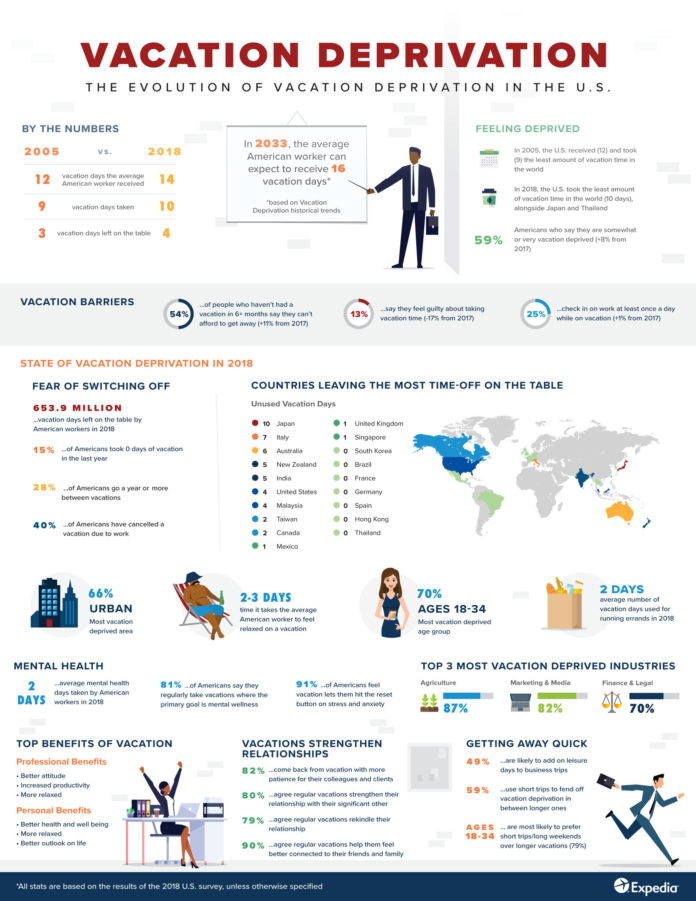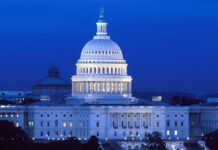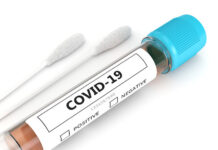Expedia study reveals U.S. workers will fail to use 653.9 million vacation days in 2018
Expedia.com® released the results of its 18th annual Vacation Deprivation® study today, which examines vacation usage and trends across 19 countries. The report found that global vacation deprivation is on the rise, and that workers in the U.S. took the fewest number of vacation days in the world in 2018, alongside Japan and Thailand.
With the number of U.S. vacation days awarded and taken at a five-year low, it’s no wonder that vacation deprivation levels for Americans are at a five-year high (59%, up 8% from 2017). According to the report, American workers received 14 vacations days and used 10, resulting in 653.9 million days left on the table in 20181.
Topline results from the 2018 report include:
- 58 percent of workers globally describe themselves as very or somewhat vacation deprived, an increase from 53 percent in 2017 and 49 percent in 2016
- Gen Z and millennials (18-34) receive two less days on average (12) than any other age group in the U.S. and feel the most deprived (68%)
- Finances are increasingly a factor for Americans who haven’t taken a vacation in the last six months, with more than half feeling like they can’t afford a trip (54%, up 11% from 2017) – more than any other country surveyed except South Korea
- Americans use an average of two of their allotted vacation days per year for “life admin” (i.e. running errands, appointments)
Expedia’s® 2018 report uncovers new attitudes and behaviors driving vacation deprivation and digs deeper into the positive effects of taking time off on mental health and self-image.
“One of the leading reasons people don’t use their vacation days is that they’re saving them for a big trip, which means they’re going longer and longer between vacations,” says Nisreene Atassi, global head of communications for Brand Expedia. “Bigger trips are great, but even a quick break can significantly improve quality of life. Aim to schedule a staycation or add an extra day onto a holiday weekend in between longer trips to get the best of both worlds.”
“Fear of Switching Off” – is it all in our heads?
63 percent of Americans go six months or longer without a vacation, with more than a quarter (28%) going a year or more sans time off. Considering time off is so precious, one might be surprised to hear that a quarter of Americans admit to checking work email/voicemail at least once a day while on vacation.
While this behavior has stayed mostly consistent over the past decade, perhaps there’s hope for future generations – younger workers are the least likely to check in frequently, at 19 percent for 18-34-year-olds, compared to 31 percent of the 50 and over crowd.
Interestingly, the pressure to be available may be self-imposed – only a small number of respondents say their managers (17%), junior staff (10%) and clients (12%) expect them to check-in daily while on vacation, proving most people need to simply give themselves permission to unplug.
Even a short getaway boosts self-esteem and confidence
With the biggest barriers to vacation being financial (54%), the desire to bank vacation days (23%) and inability to get time off work (17%), it begs the question: how long does one need to get away to reap the benefits of vacation? The study uncovered good news for those scarce on funds or time:
- Whether a long vacation (week or more) or a short one (2-3 days), post-trip people liked themselves more, felt more confidence in their ability to solve problems and felt more hopeful and outgoing.
- Longer vacations seem to yield slightly better outcomes, with each positive result seeing a roughly 10 percent boost compared to the 2-3-day trip.
Americans are savvy to this shortcut: 59 percent say they use short trips to fight off vacation deprivation in between longer getaways. To get the most out of a quick trip, try to keep travel time under four hours and choose accommodations close to the area’s main attractions.
Taking a mental break
The growing focus and conversation around mental health may be changing how Americans vacation. A whopping 81 percent of U.S. respondents say they regularly take vacations where their primary goal is “mental wellness,” and they overwhelmingly feel that vacation is a chance to “hit the reset button” on stress and anxiety (91%). Americans also report taking an average of two mental health days each year, which most feel should be considered sick days (67%), rather than vacation time.
“A wellness-centric trip doesn’t have to mean a spa or yoga retreat, although those are popular options,” says Atassi. “For most of us, recharging simply means we need to disconnect and slow down. Whether it’s a family vacation or a solo escape, set rules about how often you’re allowed to check email and try not to overschedule your days.”
For more highlights from the 2018 study and the history of Vacation Deprivation around the world, check out the Expedia Viewfinder® blog.

About Vacation Deprivation
Expedia first commissioned Vacation Deprivation in 2000 to examine the work-life balance of Americans. In 2005, Expedia began comparing behaviors across countries. As of 2018, Vacation Deprivation has grown to encompass 19 countries. 11,144 employed adults aged 18 and older were asked by Northstar about work-life balance in September 2018.
This study was conducted on behalf of Expedia by Northstar Research Partners, a global strategic research firm. The survey was conducted online from September 19-28, 2018 across North America, Europe, South America and Asia-Pacific using an amalgamated group of best-in-class panels.




